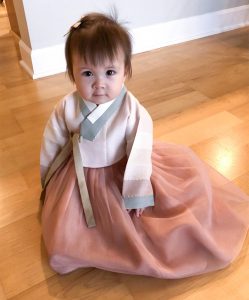
What is Seol-Nal (설날)?
Seol-Nal is one of the most important traditional holidays in Korea. It marks the first day of the year of the Korean lunar calendar. It is celebrated over three days, which allows everyone to travel to spend the holiday with their families. Seol-Nal is a day when families get together to wish each other good new year’s fortune and pay respect to their ancestors.
How do people traditionally celebrate?
Seol-Nal is often celebrated with the entire extended family on your father’s side. Women celebrate with their husband’s side of the family after they are married. Dduk-gook, rice cake soup, is always eaten for breakfast. Everyone gets one year older on Seol-Nal (as opposed to adding a year to our age on our birthdays), so kids are often told that they must eat their dduk-gook in order to get older.
Traditionally, people wore new clothes for the new year, but many families opt for wearing hanbok (Korean traditional garment) instead.
Many families still have charae, a ritual where they prepare a meal for the ancestors to pay their respects. Kids receive money after they do Korean bows called jeol to the elders of the family, a new year’s greeting called sebae. There are a few traditional games exclusively played on Seol-Nal. Yoot-nori is one of the games still popular today. Yoot-nori is a board game played with four wooden sticks, and is enjoyed by kids and adults alike.
Saehae Bok Mani Badeuseyo (새해 복 많이 받으세요)
“Wishing you lots of new year’s fortune” (Korean)
How did your family celebrate Seol-Nal in Korea?
Growing up in Seoul, I always looked forward to Seol-Nal. Because my dad was the oldest on his side of the family, we hosted the holiday at our house every year. We had everyone from my grandfather, his brothers and their families, to my dad’s brothers and their families all squeeze into our house to spend the day together. As a kid, this was my favorite time of the year.
My family kept close to the traditions when it came to Korean holidays. We all dressed in our hanbok, and early in the morning, we set up a table for charae. We always ate dduk-gook for breakfast. We did jeol to all the elders of the family, starting with my grandfather, while wishing them good new year’s fortune. My cousins and I played yoot-nori with our parents. Because my mom’s side of the family lived nearby, I went over to my grandma’s house later in the day to spend the rest of the day with my other relatives.
 How does your family celebrate Seol-Nal in Issaquah Highlands?
How does your family celebrate Seol-Nal in Issaquah Highlands?
After my family and I moved to the states, like many Korean families, we don’t celebrate Seol-Nal like we did in Korea. Because most of my family and relatives now live all over North America and Asia, it is almost impossible to get everyone together for just one day. Instead, my close family (and sometimes friends) still get together in our home to have dduk-gook for breakfast and wish each other good fortune for the new year. For those who live far from us, we send text messages wishing them happy new year. Once our daughter becomes a toddler, we plan on teaching her traditional activities like yoot-nori, so that she will get to experience what it’s like to be Korean on Seol-Nal. This Seol-Nal happens to be on our daughter’s (see photo) first birthday. We’re having a Korean doljanchi (first birthday party) mixed with a little bit of Seol-Nal tradition. We’ll be in our hanbok and start the day with dduk-gook.
Lynn White is a Starpoint resident.





